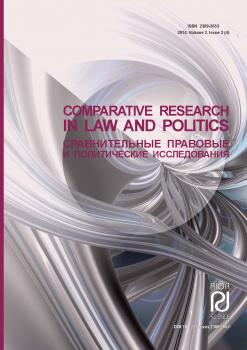Статья описывает право с позиции его как результата правовой политики и функционирования юридической техники. Она принимает во внимание взаимодополняемость формализма и антиформализма в праве. Автор определяет также право с позиции его потенциальных воз- можностей и актуализации. Он подчеркивает существование дилеммы конституционности выносимого судебного решения. Делается заключение о сути методологии правового сравнения.
сравнительное правоведение/сравнение правовых культур, право в книгах/право в действии, правовая политика, правовая техника, формализм/антиформализм в праве, право как возможность/право как реальность, конституционность вынесения судебного решения, способность к правовому воображению, лингвистическая медиация, правовой догматизм, принципы/положения.
Comparative jurisprudence as an extension of the scholarly cultivation of domestic laws, closed down within its respective national boundaries, is historically rooted in the realisation of how much the selfclosing of continental laws, based upon their national codifi cation throughout the 19th century, emptied their scholarly approach as well. In the pioneering age of comparison, the turn of the centuries, legal ideology was still marked by the predominance of statutory positivism, so the law’s comparative treatment — as a fi rst step — could not target but its statutory form. Albeit there have been quite a few mentions by the classics of legal comparativism emphasising the signifi cance of the law’s sociological entourage and cultural embeddedness, neither the direction nor the methodology of research has changed adequately and to a transformative depth since.
Markedly expressed, where the reduction of ius to lex (or, in its original meaning, право to закон) asserted itself the most uncompromisingly in the fi nal segregation of national systems of law into their jurisdictional boundaries thanks to their codifi cation, there the need was felt the most strongly to transcend national self-seclusion through extending their perspective to neighbouring and further countries, through developing the comparison of what could be seen as variations to mostly one and almost the same topic. And such an origination predestined the instrument of overcoming itself to become captive of its own genesis: statutory one-country-centeredness became cured and substituted to by statutory multi-countries-centeredness.
1. Law, inspired by legal policy and operated by legal technique
Once, at the birth of law, two human motives assisted in mutual complementation: the need of ordo [order] and the germ idea of interference through social engineering. In the course of later development the invention of law and legal policy helped to meet such requirements, which in a chick-and-eggs parallellity made up for that what was meant simply by “law”, with a unilateral emphasis on one of the sides of a complexity.
The term “legal technique” has to encompass, in principle, both legislation and the application of law. Although ‘legal technique’ is most oft en referred to in literature as the instrumental know-how of legislation [1], for me it is an instrumental skill, covering the entire legal process from making to applying the law. For, back in early historical times, human civilisation has developed something called “law”, as well as something else called “legal policy”. Th e latter symbolises, in a wider sense, the entire social medium in which a community of people, organised in a country, aims at achieving some goal(s) in a given manner through a specifi c medium. In a narrower sense, legal policy relates to the fi eld of politics as organised partly in terms of legislative power and, together or alongside with it, partly in terms of governmental power (with public administration, including crime control) and, as the third branch of the state power, in terms of judicial power — all working in their ways so that legal positivations can be implemented and actualised through a series of individual offi cial decisions [2]. In the fi nal analysis, legal technique serves in fact as a bridge between law as an issue of positivation and its practical implementation as shaped by legal policy considerations.





